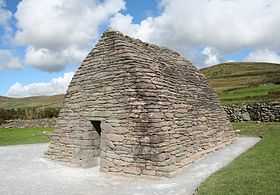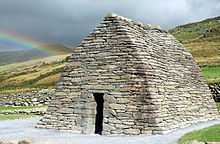Gallarus Oratory

The Gallarus Oratory (Irish: Séipéilín Ghallarais, literally "The Church of the Place of the Foreigners") is believed to be an early Christian church located on the Dingle Peninsula, County Kerry, Ireland.
The oratory overlooks the harbour at Ard na Caithne (formerly also called Smerwick) on the Dingle Peninsula.
Name
There exist several interpretations as to the origin and meaning of the Irish name Gall Aras. Archaeologist Peter Harbison ventures the meaning to be something like "The House or Shelter for Foreigner(s')", the said foreigners being "these pilgrims that have come from outside the Peninsula.".[1]
Material
The oratory is built of large cut stones from the Dingle Beds of the Upper Silurian Old Red Sandstone. Charles Smith, who discovered the edifice in 1756, described the stone as "a brown free-stone, brought from the cliffs of the sea shore, which cuts readily and is very durable."[2]
Masonry
The stones are cut on every side and end so as to fit perfectly together. They exhibit smoothly finished outside facings that follow the slant of the wall.
The edifice is usually thought to have been built without mortar, but there is evidence that even if mortar "was never visible in the wall facings it was used as a structural medium for the interior of the wall at least."[3] A thin layer of lime mortar is used to bond the stones together and to fill in small hollows in the inner faces.[4]
Morphology
The oratory’s shape has been compared to that of an upturned boat because of its sloping side walls. The edifice uses corbel vaulting. The stones are positioned on each course with their edges projecting inward by a small increment as the wall rise. Besides, they are laid at a slight angle, lower on the outside than on the inside, thus allowing rainwater to run off. Both techniques can still be seen in the modern agricultural clocháns of the Dingle peninsula.
The edifice has two side walls and two end walls, sloping and converging at the top, each of one piece, playing a dual role as load-bearing wall and corbelled half-vault. Some slight sagging has occurred across the length of the northern roof slope.
Interior
The interior room is approximately 4.8 m (15 ft) by 3 m (10 ft), a size that befits more an oratory or a small chapel than a church.
It is dimly lit, with only a tiny round-headed window in the east wall, opposite the entrance door. The window splays more widely towards the inside of the wall. According to local legend, if a person climbs out of the oratory via the window, their soul will be cleansed.[5]
The doorway is 1.67 m (5.5 ft) high. It has a flat lintel. On the inside over the lintel two holed stones project out from the wall, possibly for the attachment of a wooden door.
Date
Though the building is believed to have been built between the 6th century and 9th century, archaeologist Peter Harbison believes it could have been built as late as the 12th century for a number of reasons,[6] including because the east window has a rounded top made of two carved stones (not a true arch). Harbison also produces some evidence pointing to a later date and a different use; a letter by English traveller Richard Pococke who visited the "oratory" in 1758, two years after it was "discovered" by Charles Smith:[7] "Near this building they show a grave with a head at the cross of it and call it the tomb of the Giant; the tradition is that Griffith More was buried there, & as they call'd [it] a chapel, so probably it was built by him or his family at their burial place."[8]
Minor trial cuttings carried out at Gallarus in November 1970 yielded no finds or evidence of features or activity which might shed light on the period of construction and use of the oratory.[9]
Gallery
-

Oratory roof with sag (back view).
-
.jpg)
Oratory (front view)
-

Oratory door opening (from the inside).
-

Inside the Oratory, showing the only window.
-

Oratory (full view)
-

Oratory with rainbow (side view).
References
- ↑ Peter Harbison, Pilgrimage in Ireland: The Monuments and the People, Syracuse University Press, 1995, 224 p., p. 77: "Various suggestions have been made to explain the Irish name, Gall Aras. If slightly ungrammatical, perhaps it is simplest to take it as meaning something like 'The House or Shelter for Foreigner(s'); we might not go too far wrong in seeing the foreigners as being those pilgrims who had come from outside the Peninsula."
- ↑ Charles Smith, The Antient and Present State of the County of Kerry, Dublin, 1756, p. 191.
- ↑ H. G. Leask, Irish Churches and Monastic Buildings, vol. I, Dundalk, 1955, p. 22: “Though Gallarus is built without mortar as a structural medium, mortar in not entirely absent from the building ; very fine lime mortar has been found filling the internal joints here and there : an internal pointing to the stonework. It has also been observed filling small hollows in the inner faces of the vault, faces which were brought to a fair smooth finish with pick or punch by the builders.
- ↑ Peter Harbison, How Old is Gallarus Oratory? A Reappraisal of Its Role in Early Irish Architecture, in Medieval Archeology, N. 14, 1970, p. 34-37.
- ↑ Dingle Peninsula Gallarus Oratory - Early Christian.
- ↑ Peter Harbison, How Old is Gallarus Oratory? A Reappraisal of Its Role in Early Irish Architecture.
- ↑ also the "discoverer" of Skellig Michael monastic stone huts
- ↑ Peter Harbison, How old is Gallarus oratory, op. cit., p. 36.
- ↑ Peter Harbison, How old is Gallarus oratory, op. cit., pp. 57-58: "Finally it should be mentioned that minor trial cuttings carried out by T. Fanning at Gallarus in November 1970, on behalf of the National Monuments Branch of the Office of Public Works, preparatory to drainage works on the site, yielded no finds or evidence of features or activity which might shed light on the period of construction and use of the oratory".
- "Gallarus Castle and Oratory". Heritage Ireland. Retrieved 1 April 2010.
- O'Sullivan, Aidan (September 1998). Appreciation and History of Art. Gill & Macmillan Ltd. ISBN 0-7171-1666-2.
| Wikimedia Commons has media related to Gallarus Oratory. |
Coordinates: 52°10′21″N 10°20′58″W / 52.17250°N 10.34944°W